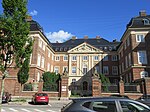Georg Carstensen

Johan Bernhard Georg Carstensen (31 August 1812 – 4 January 1857) was one of the developers of Tivoli Gardens and a Danish army officer. He spent most of his childhood in the Near East. He travelled widely and had a career in the military Royal Guards, reaching the rank of lieutenant. He attended boarding school at Herlufsholm kostskole.In 1839, Carstensen moved to Copenhagen permanently and published the periodical publications Portefeuillen and Figaro.Between 1843 and 1848, Carstensen was active in the development of Tivoli Gardens and Casino Theatre (Copenhagen) after which he joined the war at Schleswig. He learned that he was no longer required in Tivoli shortly after he returned. He was thought to have abandoned the project as he didn't extend the license of the construction.Following the disagreement with others in the Tivoli Gardens management, Carstensen travelled to the Danish West Indies and joined the army there. He was married to the daughter of an island planter and assisted in management of the property. He subsequently spent time in New York City where he designed the New York Crystal Palace – an exhibition building constructed for the Exhibition of the Industry of All Nations in 1853 – in collaboration with the German architect Charles Gildemeister.
Excerpt from the Wikipedia article Georg Carstensen (License: CC BY-SA 3.0, Authors, Images).Georg Carstensen
Geographical coordinates (GPS) Nearby PlacesShow on map
Geographical coordinates (GPS)
| Latitude | Longitude |
|---|---|
| N 55.695277777778 ° | E 12.58375 ° |











